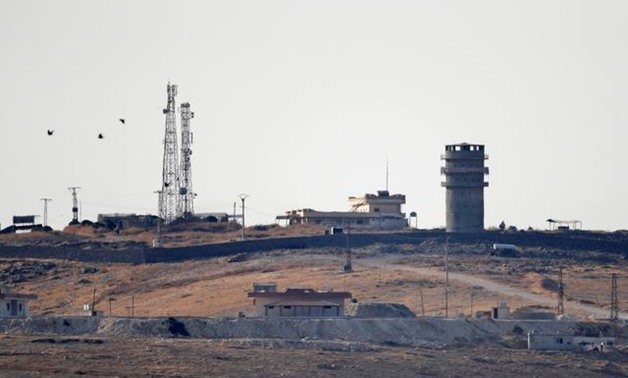
An abandoned U.S. observation post is seen from the Turkish border town of Suruc, in Sanliurfa province, Turkey, October 14, 2019. REUTERS/Murad Sezer
BEIRUT/ANKARA (Reuters) - Syria’s troops have entered a northeastern town, Syrian state media said on Monday, after Washington announced it was abruptly pulling out its forces, and its former Kurdish allies reached a deal with Damascus to help resist a Turkish attack.
The abrupt U.S. withdrawal from the eight-year Syrian war, and the potential return of the Syrian army to the Kurdish-controlled northeast, are major victories for Syrian President Bashar al-Assad and his allies Russia and Iran.
The U.S. announced on Sunday it would swiftly withdraw its remaining 1,000 troops from northeast Syria, just four days after Turkey launched its cross-border offensive with a green light from President Donald Trump.
The Turkish assault has prompted widespread criticism and alarm that it could allow Islamic State fighters in Syria to escape their Kurdish-run prisons and regroup.
Trump decided a week ago to move U.S. troops out of the way of the Turkish assault, an act denounced as a stab in the back by the Kurds, thousands of whom died fighting against Islamic State in partnership with Washington since 2014.
The Kurds announced on Sunday they were pursuing a new pact instead with Washington’s foes, Assad and his Russian backers. Meanwhile, the United States said it was pulling its troops out of Syria altogether.
Ankara says its operation aims to neutralize the Kurdish YPG militia, the main element of the Syrian Democratic Forces (SDF), which was the key U.S. partner in dismantling the jihadist “caliphate” set up by Islamic State militants in Syria.
Ankara views the YPG as a terrorist group because of its links to guerrillas waging an insurgency in southeast Turkey.
Two U.S. officials told Reuters the bulk of the U.S. pullout could be completed within days.
U.S. Defense Secretary Mike Esper indicated on Sunday that one factor behind the pullout was that the SDF aimed to strike a deal with Russia and Syria to counter the Turkish offensive. Hours later, the Kurdish-led administration said it had made such a deal for the Syrian army to deploy along the Turkish border to repel Ankara’s incursion.
Syrian state media said on Monday that Syrian troops entered Tel Tamer, a town on the strategically important M4 highway that runs east to west along the border with Turkey.
A top Syrian Kurdish official said a “preliminary military” deal with Damascus had been reached for government forces to enter border areas from the town of Manbij in the west to Derik, 400 km (250 miles) away in the northeast.
Badran Jia Kurd said the deal is limited to the army’s deployment along the border and the two sides will discuss political issues later. The Kurds have set up an autonomous administration in territory they control, while Assad aims to impose the rule of his government across all Syrian territory.
The army deployment would help the SDF in countering the Turkish offensive and “liberating the areas that the Turkish army and mercenaries had entered,” it added, referring to Turkey-backed Syrian rebels. It would allow the recapture of other Syrian cities captured by the Turkish army such as Afrin.
While the U.S. withdrawal moves American troops out of the line of fire, the return of Syrian soldiers to the border with Turkey opens up the possibility of a wider conflict should the Syrian army come in direct confrontation with Turkish forces.
SANCTIONS THREAT
Turkey says it aims to form a “safe zone” in Syria to settle many of the 3.6 million Syrian refugees it is hosting. President Tayyip Erdogan said on Sunday that the operation would extend from Kobani in the west to Hasaka in the east, and go some 30 km (20 miles) into Syrian territory, with the town of Ras al Ain now in Turkish control.
Turkey also said it seized part of a key highway some 30-35 km into northern Syria. An SDF official said clashes were going on along the road.
Turkey’s European allies have also criticized the incursion, warning of potential sanctions. Erdogan says that Turkey will “open the gates” to Europe for Syrian refugees if the European Union does not back the offensive.
Turkish armed forces continued sporadic cross-border bombardment overnight, residents on the Turkish side said. A Reuters cameraman in the town of Suruc reported occasional howitzer fire.
The fighting has sparked Western concerns that the SDF, holding large swathes of northern Syria previously controlled by Islamic State, would be unable to keep thousands of jihadists in jail and tens of thousands of their family members in camps.
The region’s Kurdish-led administration said 785 Islamic State-affiliated foreigners escaped a camp at Ain Issa. The British-based war monitor Syrian Observatory for Human Rights, citing sources in the camp, said around 100 people had escaped.
Erdogan dismissed the reports and told the state-run Anadolu news agency that accounts of escapes by Islamic State prisoners were “disinformation” aimed at provoking the West.
Trump has placed the onus on the Kurds and Turkey to restrain the Islamic State fighters and blamed European nations for not taking back their own citizens.
Turkey has said it would take responsibility for Islamic State fighters that fall within the “safe zone” it aims to form, but would not be accountable for those outside it.


Comments
Leave a Comment